Last Updated on: 5th August 2024, 11:32 am
Built on a slope of Karadag Mountain in the Maçka district of Trabzon, Sumela Monastery is one of the defining images of eastern Turkey. The monastery appears to hover in the air at 300 meters above the valley. And most surprising of all is that it’s one of the world’s oldest, dating back to the 4th century AD.
Closed for renovations for five years starting in 2015, my arrival in Trabzon just happened to coincide with Sumela’s grand reopening. While public transportation is an option, I opted for an affordable all-day tour which also included a nearby cave and additional scenic vantage points.
Learn more about getting to Sumela Monastery at the end of the article, along with whether or not it’s worth traveling to east Turkey for.
Sumela Monastery
Departing at 9:30 from central Trabzon, we rode for an hour through the picturesque outskirts of the province before arriving at Sumela.
After purchasing the ticket for 50 TL, we then had to hop in a shuttle bus (6 TL) taking us further up the mountain. And after a short uphill drive, it was another 15 minutes of walking to get to the monastery itself.
This scenic walk up to the monastery is one of the highlights of the whole experience. Walking through the tranquil nature trail, you can occasionally catch glimpses of the lush green mountains in the distance. The Black Sea region is so green due to its higher than average rainfall, but this was thankfully a rare dry day.
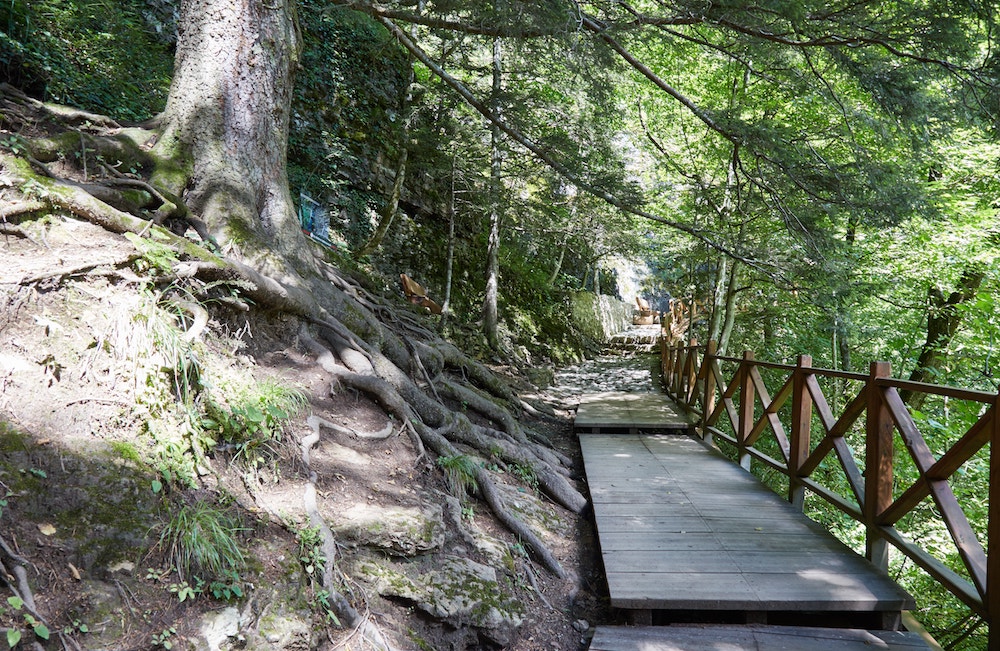
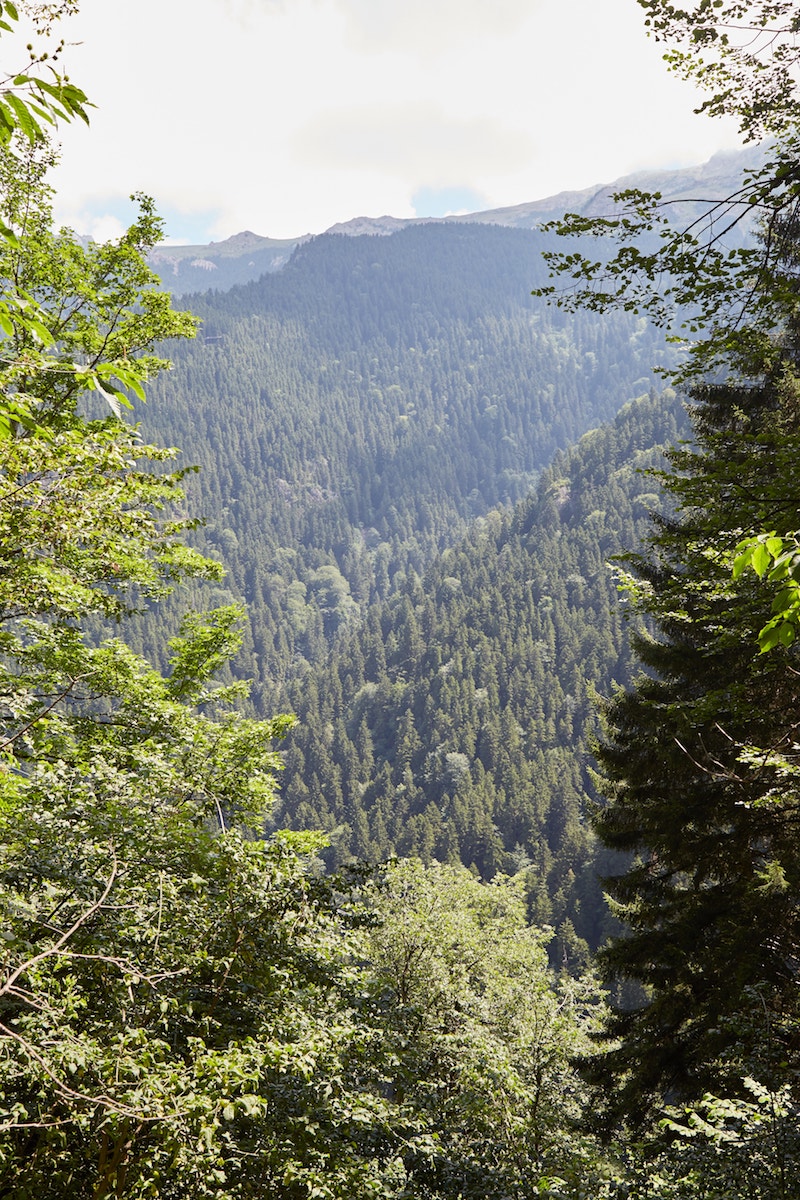

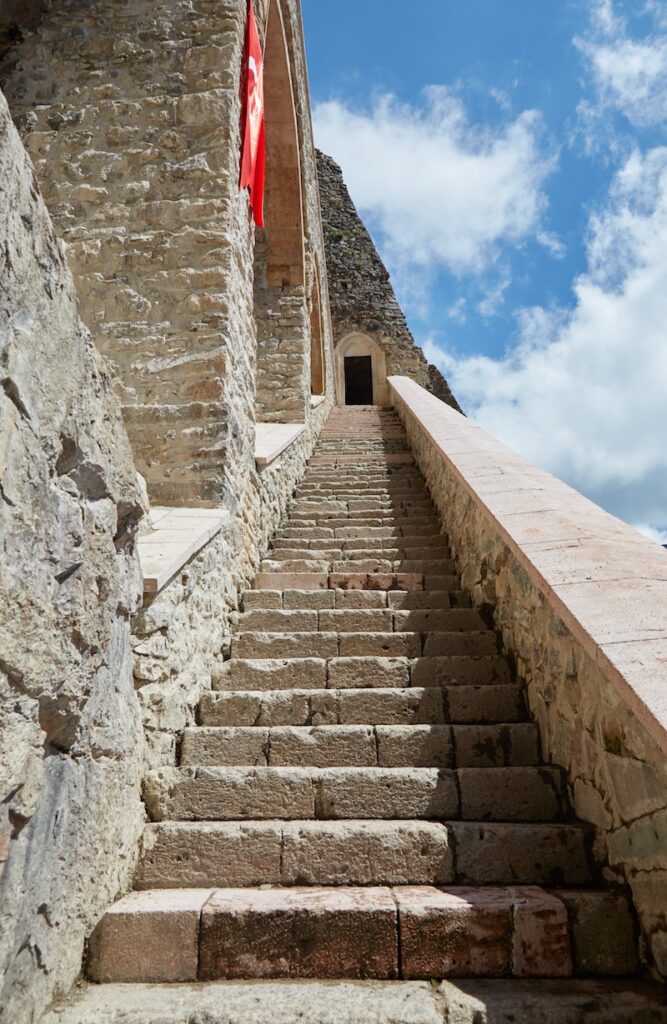

Finally arriving at the monastery, the first thing visitors encounter is an aqueduct that was used to carry water from the nearby natural springs. Another flight of stairs then leads to the core monastery. But don’t forget to turn around to appreciate the excellent views.
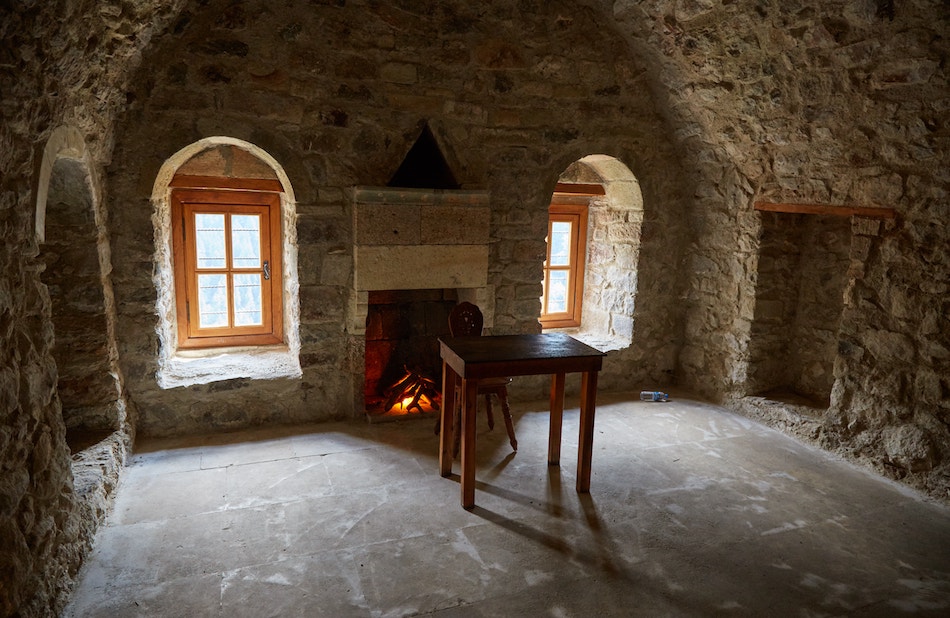

Structures around the monastery include a library, kitchen, and dwelling places for the monks. The library, one of the first rooms visitors encounter, is now void of any books. While it’s obviously been recently restored, it maintains a classical look and feel.
But the same can’t be said about all the other buildings…
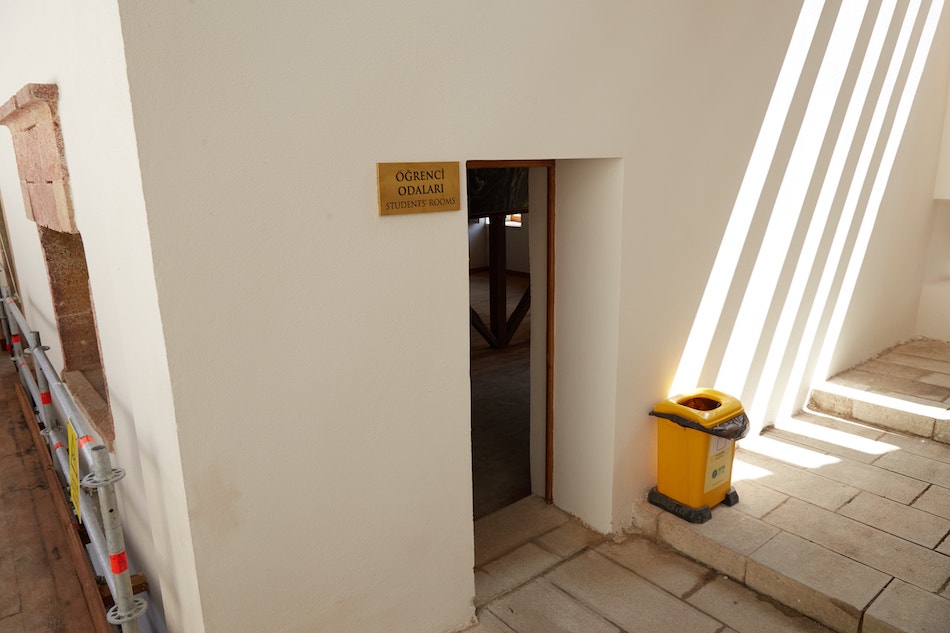

Disappointingly, rooms like the ‘Student’s Rooms’ appear to have been put together as quickly and as cheaply as possible. It’s not the type of thing one wants to encounter when visiting a 1,600-year-old monastery.
Thankfully, though, many other buildings do indeed maintain their original stone masonry.

While I was lucky to be among the first visitors to tour the monastery in years, only around 50% was accessible as of the summer of 2020.
Many other important structures were completely covered up, so I’ll have to visit again in the future to get the full picture. There are said to be additional chapels featuring murals from the 18th and 19th centuries.
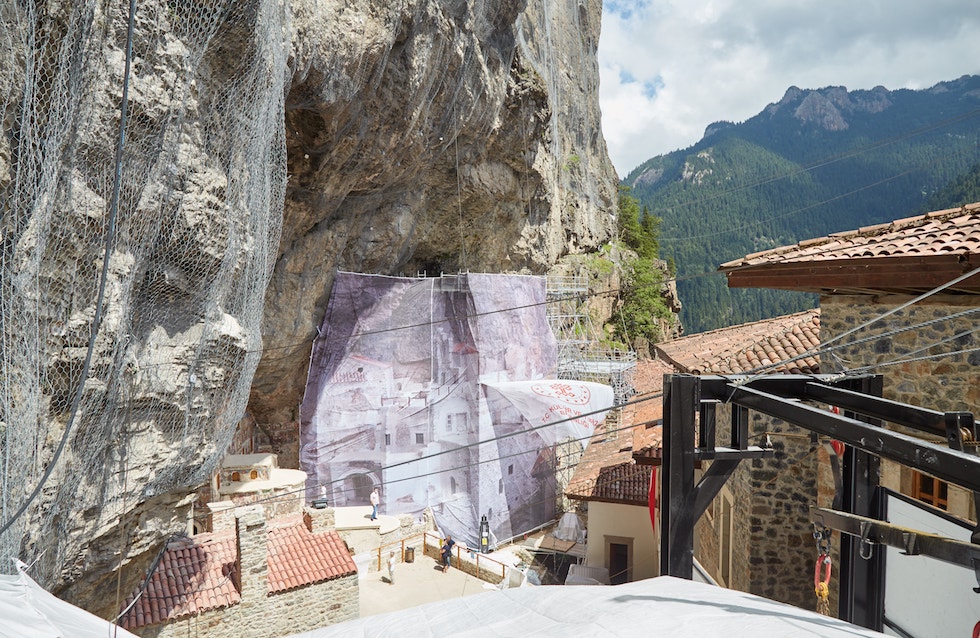
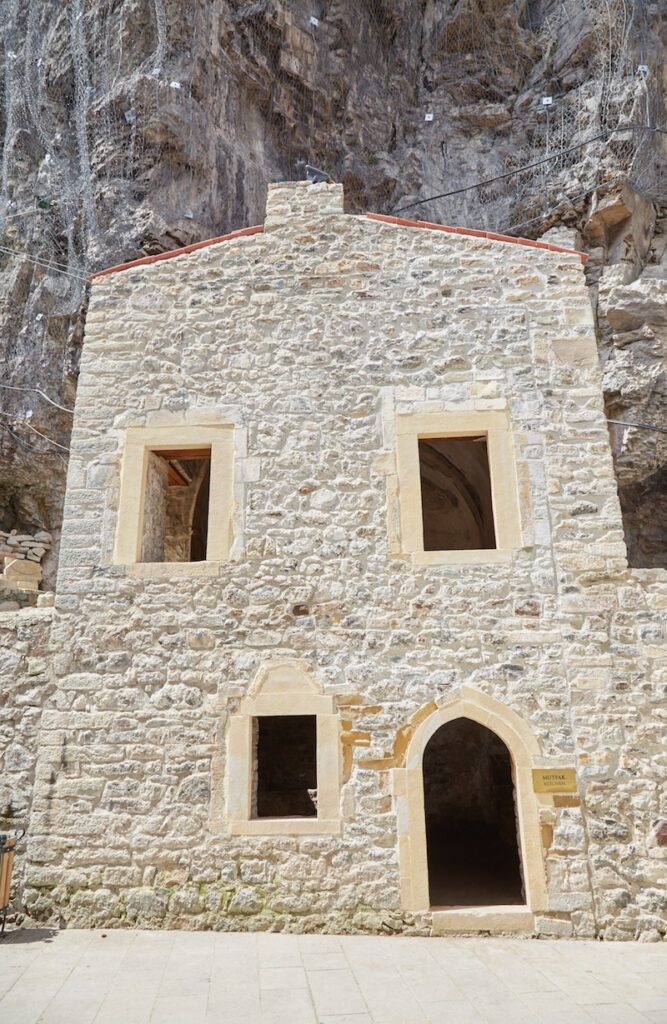
The main church, however, was fortunately accessible, and it’s immediately noticeable thanks to its colorful art. But what’s not obvious from the outside is that the painted walls were built around a natural cave. And the cave is deeply entwined with the legend of Sumela Monastery’s founding.
As the story goes, a pair of Athenian monks were spoken to by the Virgin Mary in a dream. She told them to go and find a special icon of her that had been painted by the Apostle Luke.
Mary spiritually guided them on a long journey to this remote corner of northeastern Anatolia where they came across her icon in a cave (it’s currently in Greece). The monks then founded this Greek Orthodox church which remained in constant use until the 1900s.

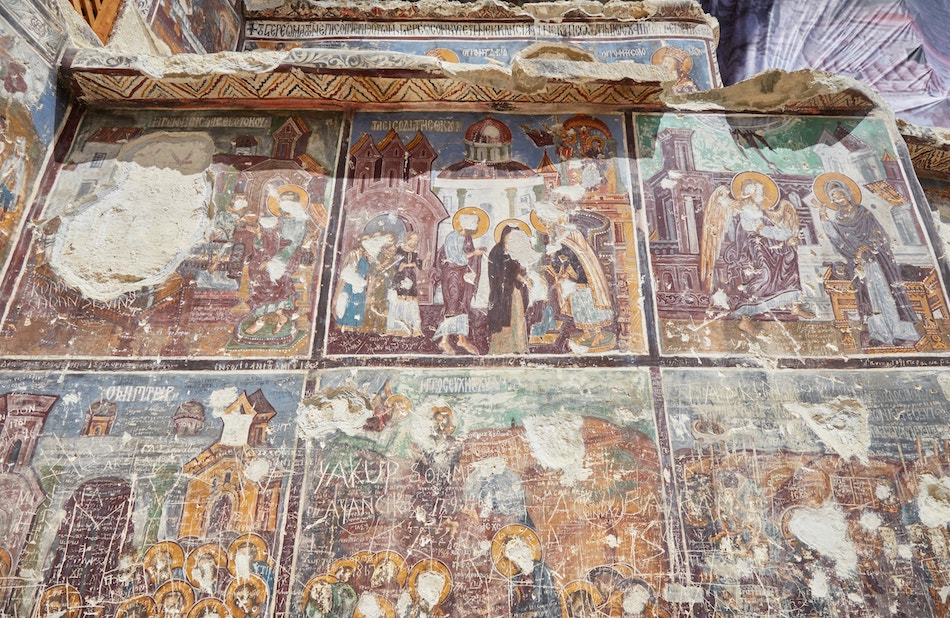

Both the outside and cave interior are entirely adorned in colorful frescoes. Subject matter includes the creation of the earth and various scenes from the New Testament such as the miracles of Jesus. And of course, the Virgin Mary makes numerous appearances as well.
Sadly, there’s a very noticeable amount of graffiti left in the 20th century that will likely be there forever.
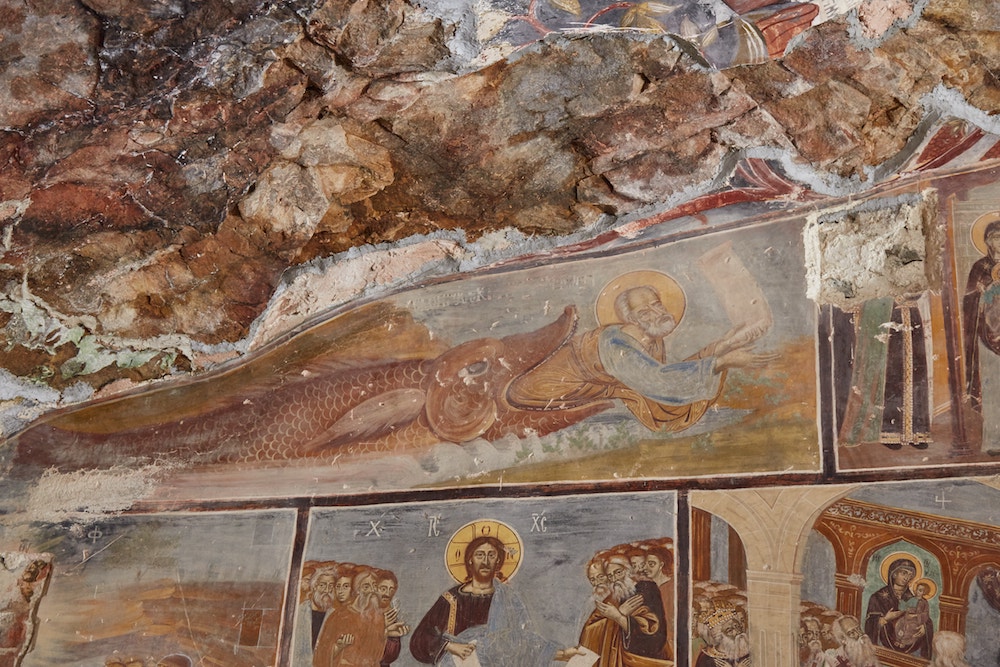
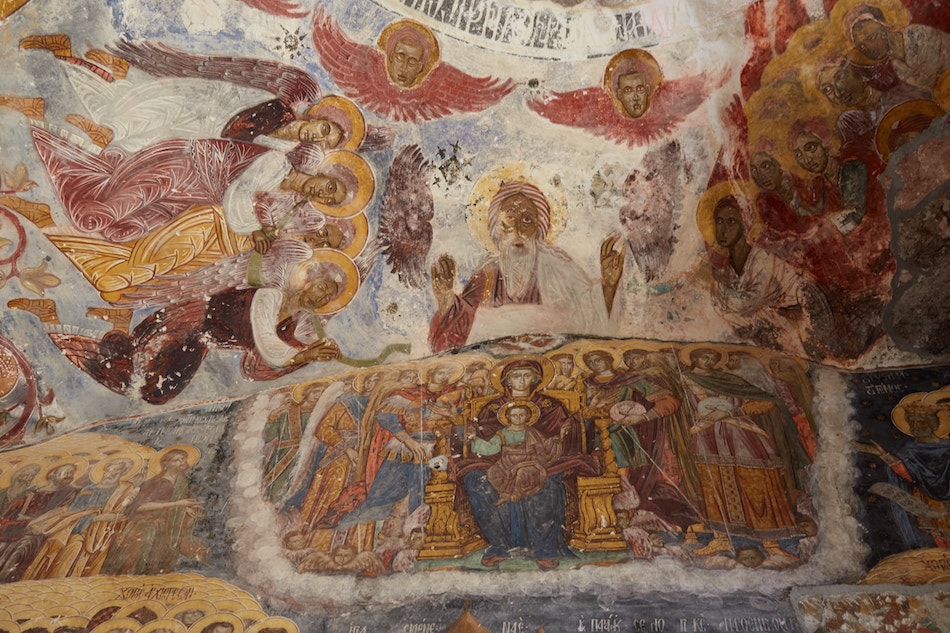
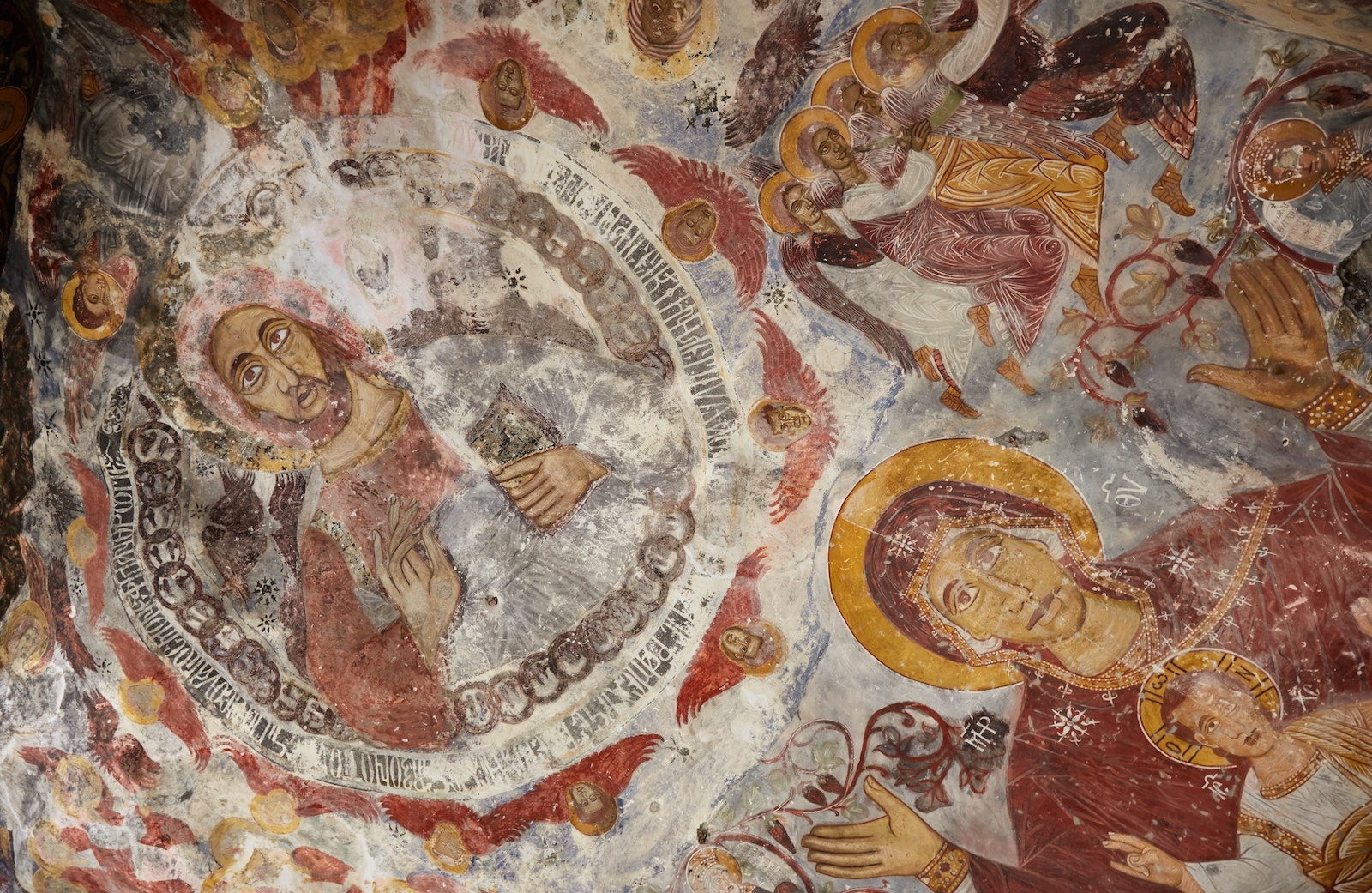
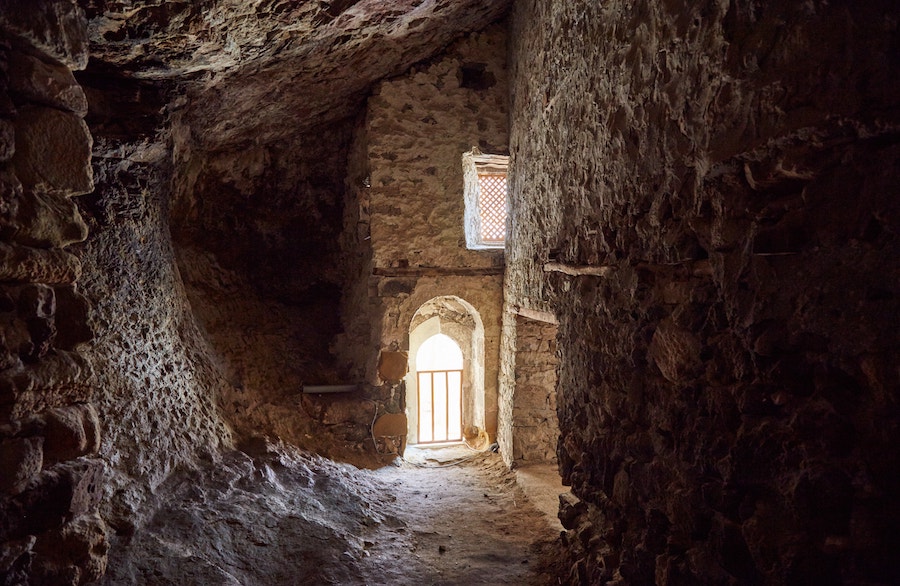

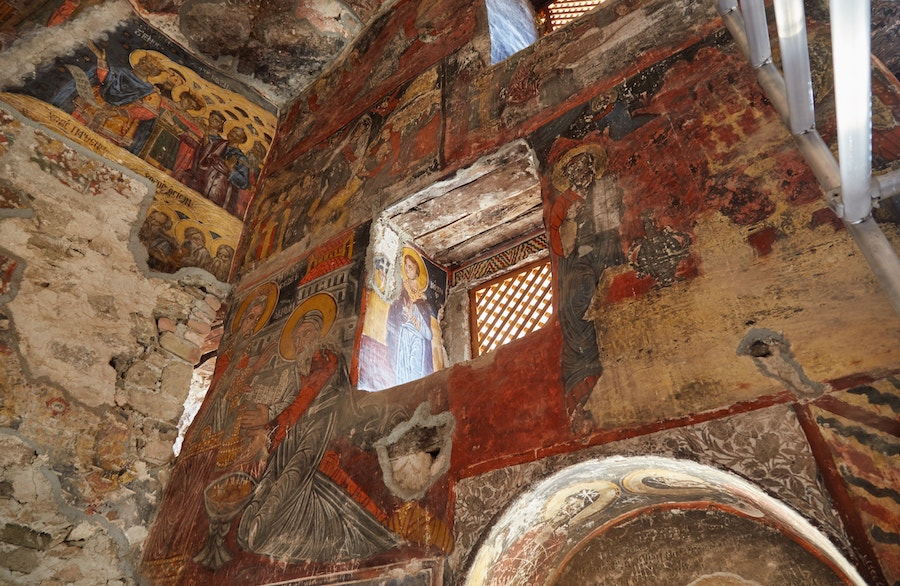
Following its founding, Sumela Monastery was restored in the 6th century and then again in the 7th century after repeated looting. Much later in the 13th century, the Empire of Trebizond took control of the area and made further repairs. The monastery then continued to remain active throughout the Ottoman Empire years.
But ultimately, in 1923, a population exchange took place between Turkey and Greece. The Turks in Greece and the Greeks in Turkey were forced to switch places, though the criteria was based upon religion rather than ethnicity. As such, Anatolia suddenly saw its Christian population plummet overnight.
Like many ancient churches across Turkey, Sumela Monastery has functioned as a secular ‘museum’ for decades (though many have since been converted to mosques by the current regime). Interestingly, though, a one-off Orthodox Mass was held here in 2010, the first since 1923.

Walking back along the trail to catch the return shuttle bus, I noticed another structure that I’d missed on my journey over. Down a short side trail is the small Aya Varvara Monastery.
The church isn’t particularly impressive and the interior was completely undecorated. But it’s from here that you can see the iconic view of Sumela Monastery seemingly hanging on the cliffside from afar.
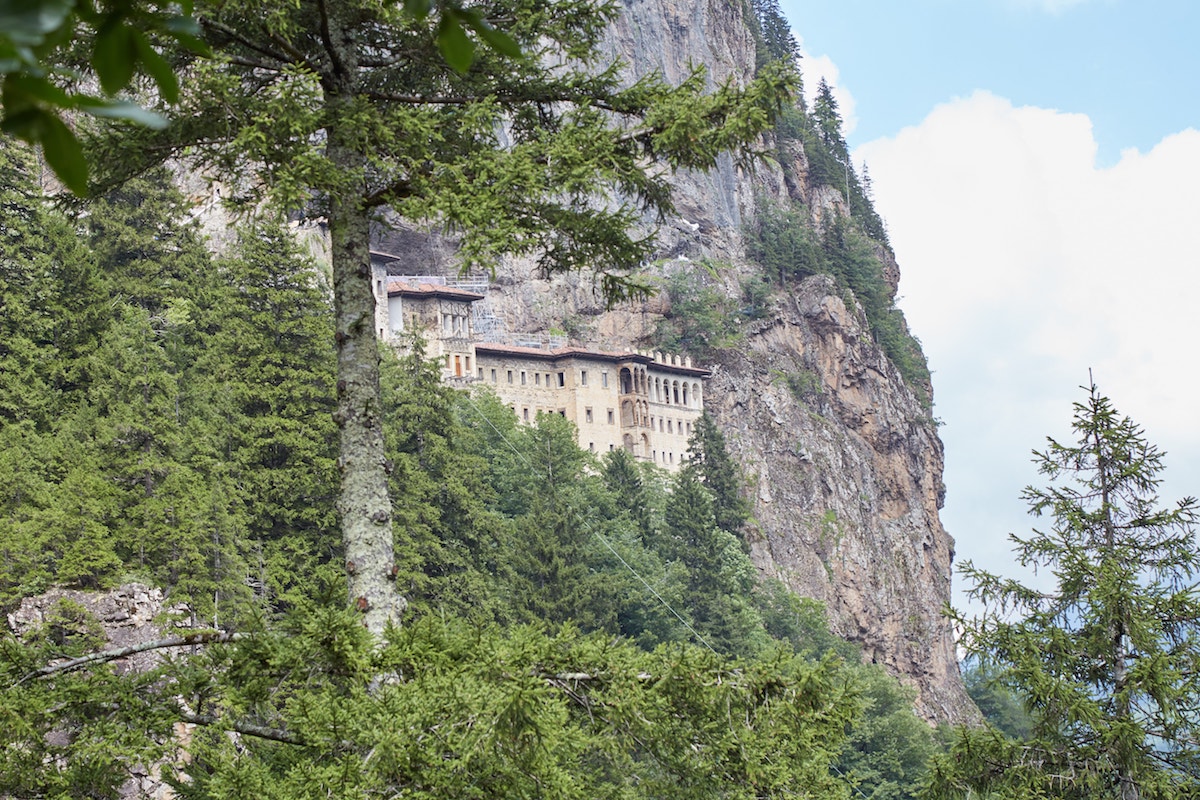
As you can tell from the photo above, the view from Aya Varvara, while nice, isn’t totally clear. It’s not the same perspective that you’ll see on brochure covers or hotel posters.
I presumed that our driver would be taking us to stop at a proper viewing spot at some point (there’s one marked on Maps.me). But unfortunately, I was wrong.
To my surprise and disappointment, it wasn’t until we arrived at the next destination that I realized we’d missed the chance to admire Sumela from afar. As the driver hardly spoke any English, there wasn’t much communication throughout the day.
Frankly, this omission put a damper on the whole day trip experience for me. I’m not sure, though, if the viewing spot would be any easier to visit via public transport.
Karaca Cave
Our next stop was for lunch at a restaurant overlooking a scenic section of the Pontic Mountain range (but it didn’t make up for missing the monastery vantage point!)
And from there it was onto our next destination, the Karaca Cave, situated in neighboring Gümüşhane Province.

Opened for tourism in 1996, the cave contains an impressive assortment of stalactites and stalagmites. While the cave itself consists of limestone, the area is surrounded by much larger deposits of harder, volcanic rock.
The lighting is well done, while a sturdy wooden walkway is there to take you to the various sections.


The highlights are the pretty dripstone pools and travertines, but all in all, there’s not a while lot to see.
In total, the visit shouldn’t take more than fifteen minutes or so. Seeing as we had an hour before our departure, I passed the time sipping Turkish tea overlooking the scenic mountains.


Torul Glass Observation Terrace
Our next stop was the Torul Glass Observation Terrace. Opened in 2018, the observatory seems to have been influenced by the adrenaline-pumping glass bridges and walkways throughout China.

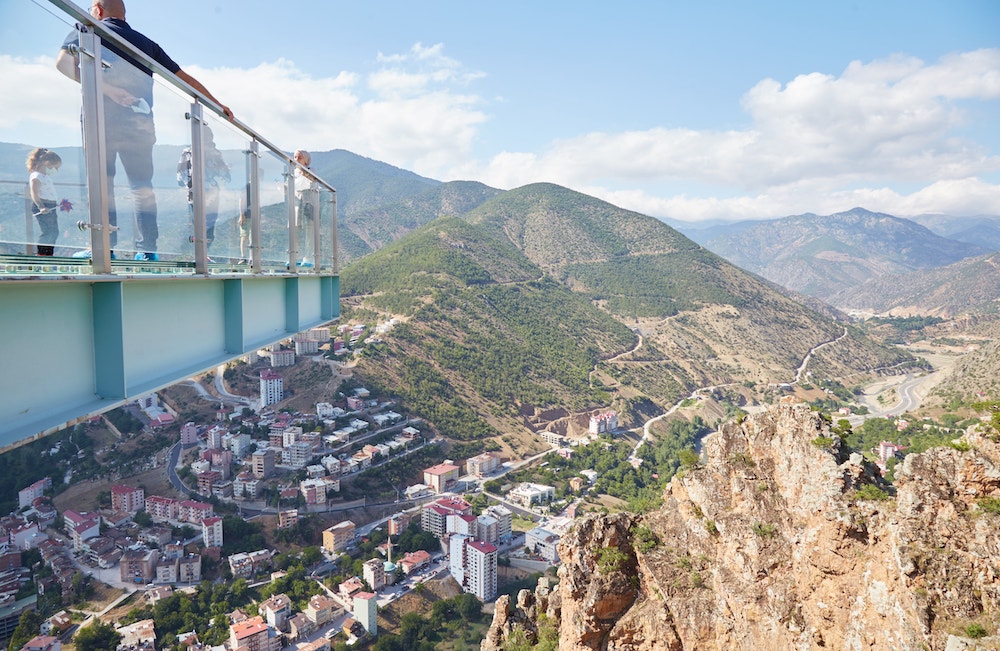
The platform, which floats over the landscape at 200 meters high, appears to be supported by nothing at all. It’s definitely not for those with even the slightest fear of heights.

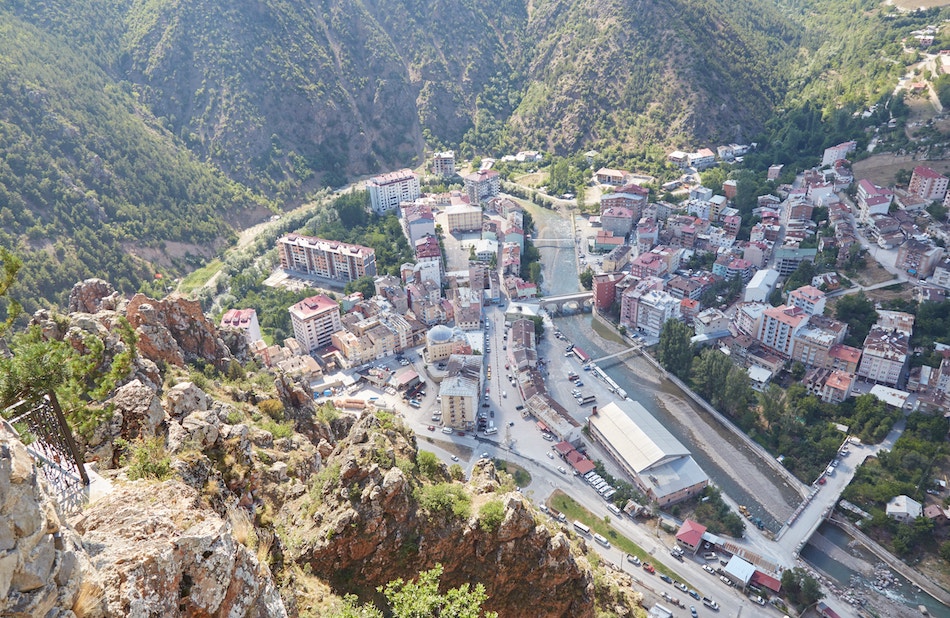
But if you’re not up for it, don’t worry. You can sit things out at a nearby cafe from which you can still get decent views of the impressive surroundings.
Supposedly, there’s a castle nearby which is also named Torul, though it’s not visible from the observation terrace.

Hamsiköy
Our next and final stop was the village of Hamsiköy. If you say ‘Hamsiköy’ to anyone in Turkey, they’ll immediately think of Hamsiköy Sütlacı, a popular type of rice pudding. I just wish I’d know this at the time!
I thought we’d simply stopped at a local restaurant to enjoy the excellent views from the terrace. Not feeling very hungry, I ordered a basic soup. Only later, when walking around outside, did I notice that every single restaurant in town was promoting its rice pudding!

The travel brochure from my tour company simply listed ‘Hamsiköy’ as a stop with no info about it, so I didn’t know any better. But now that you do, be sure to try the sütlacı if you make it there.
After a long day out, we were eventually dropped off in central Trabzon by early evening. All in all, it was a nice trip. But was doing the tour really the best way to see Sumela Monastery? Read more below.
Additional Info
SUMELA MONASTERY BY PUBLIC TRANSPORT
It’s possible to reach Sumela Monastery by public transport, though there are hardly any details online. In Trabzon, I saw buses headed directly for Sumela Monastery departing from the same terminal as those leaving for Uzungöl.
This is not the small dolmuş (minibus) terminal near Meydani Park, but further downhill next to the highway which runs along the coast. It’s clearly marked on the Maps.me app as ‘Minibus to Maçka & Sumela.’
Depending on where you’re coming from, this area can be tricky to access due to the varying elevation of Trabzon city, but you should figure it out eventually.
You will have to confirm prices and times once you’re there, but the buses are said to be roundtrip.
It’s also possible that direct buses to Sumela Monastery only run in summer. If that’s the case, just head to the town of Maçka first and then take a taxi or minibus from there.
SUMELA MONASTERY BY GROUP TOUR
Public transport in the Black Sea region can be tricky, which is why I booked a couple of tours during my time in Trabzon. And they’re surprisingly affordable, probably because they’re more targeted toward domestic tourists.
I booked with a company called Sumela Tour and I only paid 120 TL (around $15 USD – the amount in Turkish lira will likely keep rising due to inflation) for the entire day trip mentioned above. But this didn’t include entry fees to any of the sites, nor did it include lunch.
There was no guide but just a driver. And on this particular tour, there were only three other people in the van with me.
As mentioned above, my main gripe with the tour was that they didn’t stop at any vantage point for a clear view of the monastery from afar. Before my trip, I was expecting this to be the highlight of the day, but it didn’t even happen.
While I booked with Sumela Tour, I stopped in a few other offices around town and they all seemed to offer similar tours for the same price.
I have no idea if any of the other tour companies make the effort to visit the Sumela vantage points or not. But now that you know you might miss it, I’d recommend communicating clearly with the staff before booking the tour that you want to stop there.
Sumela Monastery is the most famous landmark of the Trabzon region and Turkey’s Black Sea region in general. If you’re anywhere near northeastern Turkey, then yes, you should absolutely visit Sumela Monastery.
But is the monastery worthy of a long trip from another part of the country? Probably not.
While the monastery is certainly interesting, and the Black Sea region as a whole is beautiful, there are just so many other more interesting places to see in Turkey’s eastern half.
If you can only visit a few parts of the east, I’d much more highly recommend the southeastern part of the country (Van, Mardin, Urfa, etc.) over the Black Sea coast.
If I had to sum up the Black Sea region in a few words, it would be ‘pleasant but a bit bland.’
Of course, some people visit the Black Sea region specifically for its greenery, cooler weather, and for trekking in that kind of environment. If that’s what you’re looking for then by all means, go ahead and visit.
If you’re visiting Trabzon from within Turkey, the two main ways to visit the city are by plane or by bus. Trabzon International Airport (TZX) has regular flights between major cities like Istanbul, Ankara and Izmir.
Trabzon is the biggest city in Turkey’s northeast and there are direct buses coming in from all over the country.
As for those visiting Trabzon from Georgia, you can take a direct bus from the Sarpi border crossing with Batumi. But if you don’t see one, you’ll have to negotiate with the local taxi mafia for a ride to the nearest town of Hopa. From there you should easily find a coach bus to Trabzon and the ride should last about 3 hours.
The most convenient place to stay in Trabzon would be somewhere nearby Meydan Park. This gives you easy walking access to all of the locations mentioned above, and there are plenty of restaurants and tour agencies around here as well.
However, when looking online, you’ll likely notice how few central hotels are actually listed on sites like Hotels.com or Booking.com. Strangely, all across Turkey, many hotels don’t bother to have any sort of online presence.
The cheapest private room I found on Hotels.com was a hotel called Bordo Hotel. It was about 15 minutes on foot from the otogar (bus terminal), and twenty minutes on foot from the city center.
This worked out well for me because I was arriving overland from Georgia and didn’t have a SIM card upon my arrival. I liked the idea of being able to just walk to the hotel.
Bordo is situated in an ugly part of town, along a main highway where there’s nothing but auto parts shops. But the location was walkable enough from the center, and my room was surprisingly quiet. The downsides were lack of English spoken by the staff, no laundry service and no breakfast (the cafe area was being renovated).
I was paying 90 TL a night, which during my stay, was around $13 or $14. But with the Turkish lira in freefall, local prices in Turkey are constantly changing.
While the Turkish government isn’t quite as extreme as China when it comes to online censorship, you’ll probably want a decent VPN before your visit.
I’ve tried out a couple of different companies and have found ExpressVPN to be the most reliable.
Booking.com is currently banned in the country (at least when you search for domestic accommodation). However, there are actually quite a few Turkish hotels listed on there anyway. And many them don’t even appear on Hotels.com, which isn’t banned in the country.
Over the course of my trip, I ended up making quite a few reservations with Booking.com and was really glad I had a VPN to do so.
Another major site that’s banned is PayPal. If you want to access your account at all during your travels, a VPN is a must.
While those are the only two major sites that I noticed were banned during my trip, Turkey has even gone as far as banning Wikipedia and Twitter in the past.
